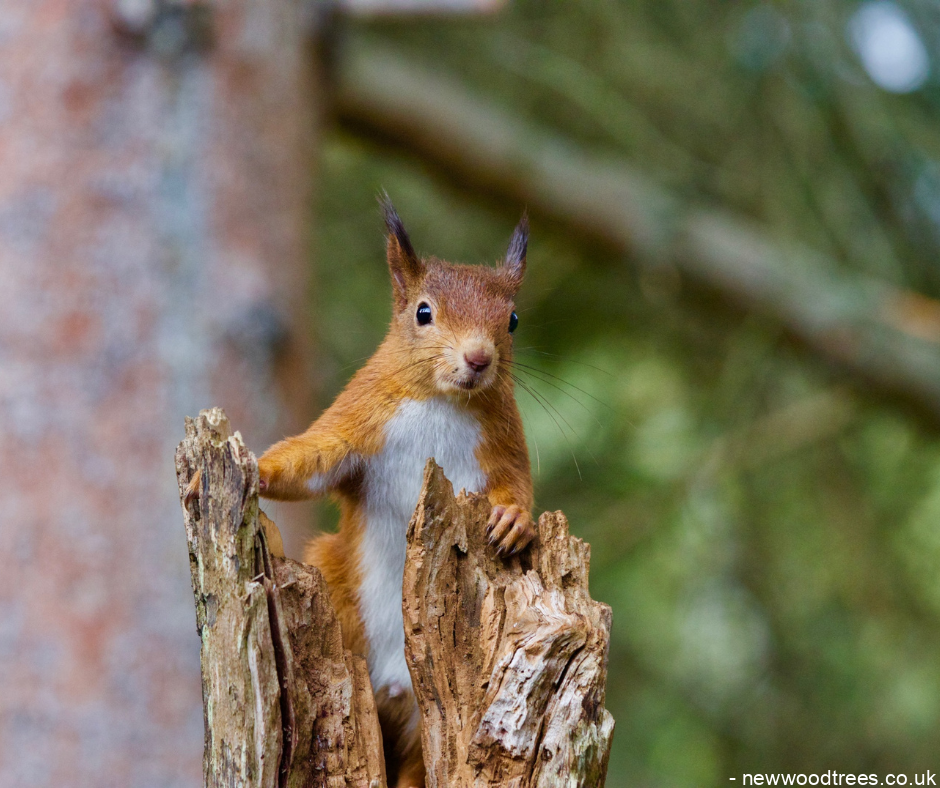We are often asked which are the best trees for encouraging wildlife into a garden. Numerous wildlife species might find a thriving existence in a single tree. It’s a world in which roots and branches provide cosy places to rest and build nests while seeds and leaves are brimming with nutritional goodness, sustaining various species. It’s little wonder that customers are keen to find the best medium and large trees for encouraging wildlife.
As of Spring 2023, the British landscape features 3.25 million hectares of sprawling woodland. Woodland settings represent 13% of the UK’s total land area; 19% in Scotland, 15% in Wales, 10% in England, and 9% in Northern Ireland. Of that amount, 1.44 million hectares (44% of the total woodland area on the UK map) have received official certification.
Numerous types of trees flourish in British woodland, with many favoured by animals, insects, and even fungi. Certain wildlife species rely on trees for food, shelter, and reproduction. A fun fact is that birds also contribute. As a result of them gorging on the fruit-bearing trees, their seeds are dispersed, ensuring the continuation of the life cycle.
So, whether you’re a nature enthusiast or a landowner keen to create a hive of insect and mammal activity, let’s explore the world of the best medium and large trees for encouraging wildlife and attracting inquisitive creatures to your outdoor space.
The Right Types of Trees for Encouraging Wildlife
Which types of trees for encouraging wildlife will you choose for your outdoor space? Although some types of wildlife are welcome, others can damage trees, so watch for pesky tree-harming animals when propagating your plants. The key to maintaining tree health is distinguishing between welcome and unwelcome wild creature activity.
Squirrels, voles, rabbits, badgers, hedgehogs, foxes and deer may not be as friendly to certain types of trees UK as other types of wildlife might. Small animals like these can kill trees by devouring their fruits, freshly developed leaves, tree bark, branches, and roots.
On the other end of the spectrum, many tree species will fascinate friendly fauna, some of which we highlight below:
The first Quercus ilex grew on British soil in the late 1500s. Naturally embellished with foliage resembling holly, it’s no wonder why this type of wildlife-attracting tree is referred to as “Holm Oak,” with “holm” meaning “holly.” As a tree that maintains its verdant green leaves year-round, Quercus ilex is also known as the “Evergreen Oak.”
- Height and Spread: This broadleaf tree blooms to 20m with an oversized, rounded crown.
- Conditions: Clay, drained, and sandy soil helps Holm Oak proliferate. The Holly tree can withstand drought once established adequately in full and dappled sunlight—plant seeds between September and December.
- Features: Smal,l deep green leaves with light undersides. During spring, yellow catkins grow on the Holm Oak tree, which has dark, finely ruptured bark.
- Benefits for Wildlife: Bees and other small insects load on pollen from the nectar and pollen-rich catkins. Birds seek year-round shelter beneath the thick, evergreen canopy.
2. Sorbus intermedia (Swedish Whitebeam)
Renowned for withstanding harsh climates, this tree flourishes with dark, bright yellow to red foliage and ovoid-shaped leaves with a serrated leaf margin. The tree, native to northwestern Europe, first appeared in the Baltics and Scandinavia. It features tightly clustered white flowers that cushion the pea-sized red fruits (pomes) that emerge around April.
- Height and Spread: Most types of Swedish Whitebeam stand between 10 and 18m, with a spread of 9m-12m.
- Conditions: Humus-rich soils work well for this type of wildlife-attracting tree, which benefits from sun and shade. The flowering months are May to June.
- Features: Sweet and sour-tasting rich red fruits. Oval, pinnately lobed leaves with tomentose undersides. The bark is blackish-grey, smooth, and etched with fine grooves.
- Benefits for Wildlife: Various species of insects pollinate Swedish Whitebeam flowers, including bees and butterflies. Birds will never get bored of this tree either, with the berries providing a source of nutrition for thrushes and waxwings.
3. Pinus sylvestris watereri – Scots Pine
You won’t regret adding this evergreen conifer to your garden. Scots Pine is native to northern Europe and was formerly used to produce charcoal, tar, resin, turpentine, and ship masts. It thrives well in sunny and shady spots. The timber sourced from Scots Pine is ideal for paper pulp, fences, storage boxes, flooring, and construction lumber.
- Height and Spread: Mature trees may grow to 32m and can live for as long as 700 years.
- Conditions: Grows at a slow to medium rate in full sun and partial shade. It must be well-ventilated and planted in high-quality soils, such as chalk, clay, loam, or sand.
- Features: Pairs of blue-green needles stretch 4–7cm long. Clusters of egg-shaped cones spike backwards along the stem, and scaled wooden cones hang from Scots Pine.
- Benefits for Wildlife: if you’re in the wilds of Scotland, you’ll spot wood ant and Rannoch looper, as well as the black-feathered capercaillie, the crested tit and the Scottish crossbill. Mammals which favour its fruits include red squirrels, pine martens and even Scottish wildcat. If you’re further south, it is also the main caterpillar food plant for the pine hawk-moth.
4. Sorbus aucuparia – Rowan (Mountain Ash)
The history of Sorbus aucuparia intertwines with witchcraft and folklore, but you’re more likely to see a flock of birds around one of these trees than a dragon or a serpent. Legend has it that the berries — each resembling a pentagram opposite its stalk — can be burned with incense for divination and enhanced psychic powers. Our ancient ancestors believed the Rowan to be a protective tree, one of over 100 species belonging to the Sorbus family.
- Height and spread: Varies, but some species climb to 20m and spread 10m wide. The average height is 10m.
- Conditions: Grows to full potential in full sun and fertile, well-drained soils, such as chalky, neutral, or slightly acidic soils.
- Features: Ornate pinnate or lobed leaves with dark surfaces and pale grey-green undersides.
- Benefits: Blackbirds and starlings visit to devour berries soon after they emerge. Chicks favour trees from the Sorbus family for the aphids and sawflies – just two of 160 species of insect that frequent this tree.
5. Crab Apple – Malus ‘Evereste’
Abundant in the temperate zone of the Northern Hemisphere, the Crab Apple tree is a potent form of pollination for other fruit trees, and their exquisite blooms will brighten up even the dullest of yards. These apple trees come in exotic and hybrid species.
Malus’ Evereste’ was initially brought to Europe in 1623 by English colonists journeying from North America. Expect to wait 3-5 years post-planting before the flowers fully blossom, but when they do, they are a magnet for birds, bees, and butterflies.
- Height and Spread: This small conical tree usually grows up to 8m tall
- Conditions: Malus sylvestris should be planted in fertile soil (hefty soils) with access to plenty of sunlight for maximum yield.
- Features: The ‘Evereste’ fruit grows up to 3cm long. Bunches of cherry-sized red fruits are enveloped by ovate leaves with serrated margins and aesthetically-pleasing foliage in shades of white, pink, and red.
- Benefits for Wildlife: Expect to see bees collecting nectar from the Crab Apple’s flower tree during spring. Throughout the rest of the year, greenfinches, robins, starlings, and thrushes flutter among 90+ insect species.
6. Prunus mahaleb – St Lucie Cherry
This species of cherry tree produces perfumed fruits that birds love. It is native to parts of Asia, Africa, and Europe. The fragrant waft of Prunus mahaleb’s pure white flowers will pleasantly tickle the nose hairs, while the sound of bees buzzing will instill a feeling of calm. Plants of the World Online approved two subspecies in February 2023.
- Height and Spread: Grows up to 10m high
- Conditions: Plant in well-drained soil with ample sun exposure and moderate moisture.
- Features: Grey-brown bark with shallow fissures and ovate/cordate leaves with serrated edges
- Benefits for Wildlife: Bees pollinate the flowers, while birds peck at the dark purple/black cherries.
Commonly called the “European Hazel,” this thick shrub first cropped up on the British Isles, Western Asia, and the Iberian Peninsula. Cold and frost-resistant, Hazel belongs to the birch family Betulaceae.
- Height and Spread: Rarely grows taller than 2m.
- Conditions: Hazel trees require full sun or semi-shade exposure. They are adaptable to most soil types with a pH between 5.5 and 7.5.
- Features: Several stems of plants extend from this stout shrub. The multi-stem canopy displays yellow male catkins in spring and hazelnuts in the late summertime.
- Benefits for Wildlife: You’ll see caterpillars munching on the leaves of the Hazel tree, and it also provides delicious hazelnuts to squirrels.
Practising the PINE Method for Trees
Remember, trees don’t need humans to grow, but some types of wildlife depend on them to survive! Create the perfect environment for wildlife to flourish by focusing on the PINE method: prune, inspect, nourish, and extend.
Prune unruly branches to foster fast tree growth, and regular inspections will prove helpful for detecting disease, insect or animal damage, and dying limbs. Use water and organic mulch — such as grass clippings, pine needles, cocoa hulls, and wood chips — to nourish trees and extend the forthcoming growing season by planting new trees during the autumn.







